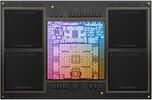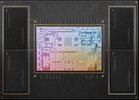Apple M2 Max 38-Core GPU vs Apple M2 Pro 16-Core GPU
Apple M2 Max 38-Core GPU
► remove from comparison
Die Apple M2 Max 38-Core GPU ist eine von Apple selbst designte Grafikkarte im Apple M2 Max SoC und laut Apple mit allen 38 Kernen. Die GPU hat keinen dedizierten Grafikspeicher aber kann auf den schnellen gemeinsamen LPDDR5-6400? Speicher (unified Memory, 32 bis 96 GB, 400 GBit Bandbreite) zugreifen.
Neu ist beim M2 Pro und Max der Support für HDMI 2.1 (8K Displays).
Die iGPU unterstützt Apple's Metal 2 Schnittstelle und dürfte eine ähnliche Architektur wie die älteren PowerVR Grafikeinheiten (z.B. im Apple A10) aufweisen.
Da der SoC im 5nm Prozess bei TSMC hergestellt wird, sollte die Energieeffizienz hervorragend sein. Laut powermetrics braucht die GPU bis zu 53,6 Watt (Chip inkl. CPU gesamt 89 Watt).
Apple M2 Pro 16-Core GPU
► remove from comparison
Die Apple M2 Pro 16-Core GPU ist eine von Apple selbst designte Grafikkarte im Apple M2 Pro 10-Kern SoC und laut Apple mit 16 der 19 Kernen aktiviert (aktuell im Einstiegs-MacBook Pro 14 verbaut). Die GPU hat keinen dedizierten Grafikspeicher aber kann auf den schnellen gemeinsamen LPDDR5-6400? Speicher (unified Memory, 16 oder 32 GB) zugreifen.
Laut Apple soll die 19-Kern-Variante GPU 30% schneller sein als die alte 16-Kern GPU im M1 Pro sein. Daher sollte die 16-Kern-Variante ebenfalls schneller sein als die 16-Kern GPU im M1 Pro (aber nur minimal) und natürlich den direkten Vorgänger mit 14-Kernen deutlich abhängen.
Neu ist beim M2 Pro der Support für HDMI 2.1 (8K Displays).
Die iGPU unterstützt Apple's Metal 2 Schnittstelle und dürfte eine ähnliche Architektur wie die älteren PowerVR Grafikeinheiten (z.B. im Apple A10) aufweisen.
Da der SoC im 5nm Prozess bei TSMC hergestellt wird, sollte die Energieeffizienz hervorragend sein.
| Apple M2 Max 38-Core GPU | Apple M2 Pro 16-Core GPU | |||||||||||||||||||||||||||||||||||||
| Apple M2 Serie |
|
| ||||||||||||||||||||||||||||||||||||
| Pipelines | 38 - unified | 16 - unified | ||||||||||||||||||||||||||||||||||||
| Speichertyp | LPDDR5-6400 | LPDDR5-6400 | ||||||||||||||||||||||||||||||||||||
| Shared Memory | nein | nein | ||||||||||||||||||||||||||||||||||||
| Stromverbrauch | 53 Watt | |||||||||||||||||||||||||||||||||||||
| Herstellungsprozess | 5 nm | 5 nm | ||||||||||||||||||||||||||||||||||||
| Notebookgröße | mittel (15.4" z.B.) | mittel (15.4" z.B.) | ||||||||||||||||||||||||||||||||||||
| Erscheinungsdatum | 17.01.2023 | 17.01.2023 |
|
| ||||||||||||||||


 Deutsch
Deutsch English
English Español
Español Français
Français Italiano
Italiano Nederlands
Nederlands Polski
Polski Português
Português Русский
Русский Türkçe
Türkçe Svenska
Svenska Chinese
Chinese Magyar
Magyar



